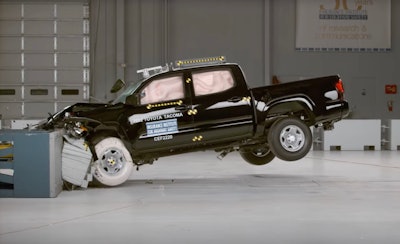
The Toyota Tacoma may rank as the nation’s most popular midsize truck but a new crash test performed by the Insurance Institute for Highway Safety shows that it’s also the most vulnerable when it comes to possible passenger injuries.
The overall safest midsize crew cab according to IIHS is the 2022-2023 Nissan Frontier.
IIHS makes clear that Tacoma is not the only truck that earned poor marks after being subjected to a new crash test that focuses more on passengers in the rear seat.
“Our updated moderate overlap front crash test proved to be challenging for small pickups,” said IIHS President David Harkey. “A common problem was that the rear passenger dummy's head came dangerously close to the front seatback, and in many cases, dummy measurements indicated a risk of neck or chest injuries. All these things tell us that the rear seat belts need improvement.”
None of the pickups in the front crash test received a ‘good’ overall rating which is mostly based on seven possible injury measurements. The top overall rating is ‘good’ followed by ‘acceptable,’ ‘marginal,’ and ‘poor.’ Only the 2022-2023 Nissan Frontier rated acceptable; the 2022-2023 Ford Ranger received a marginal rating; and the 2022 Chevrolet Colorado, 2022-2023 Jeep Gladiator and 2022-2023 Toyota Tacoma all received a ‘poor’ overall safety rating.
[Related: 2024 Tacoma takes the lead over Ranger Raptor]
The 2022-2023 Tacoma had the lowest marks overall with two poor ratings given for rear passenger injuries following the updated front crash: one for head and neck and the other for chest.
IIHS launched the updated moderate overlap front test last year after research showed that in newer vehicles the risk of a fatal injury is now higher for belted occupants in the rear than for those in front.
According to IIHS the rear seat has not become less safe. Rather, the front seat has become safer because of improved airbags and advanced seat belts that are rarely available in back.
Even with all the concern for rear seat safety following the new test, IIHS still upholds the back seat as being the safest place for young children who otherwise may be injured by an airbag in the front seat.
 IIHS
IIHS
Dummy science
To encourage manufacturers to improve rear-seat protection, the updated test adds a dummy in the back seat behind the driver. The driver dummy is the size of an average adult man. The rear dummy is the size of a small woman or 12-year-old child. IIHS researchers also developed new metrics that focus on the injuries most frequently seen in back-seat passengers.For a vehicle to earn a good rating, there can’t be an excessive risk of injury to the head, neck, chest or thigh, as recorded by the second-row dummy. The dummy should remain correctly positioned during the crash without sliding forward beneath the lap belt (or “submarining”). The head should also remain a safe distance from the front seatback and the rest of the vehicle interior. A pressure sensor on the rear dummy’s torso is used to check whether the shoulder belt is too high, which can make the restraint system less effective.
As in the original test, the structure of the occupant compartment must maintain adequate survival space for the driver, and measurements taken from the driver dummy shouldn’t show an excessive risk of injuries.
All five small pickups provided good protection in the front seat. However, measurements indicated a slightly higher risk of leg or foot injuries to the driver in the Gladiator and Tacoma.
In the Colorado, Frontier, Ranger and Tacoma, the restraints in the back seat allowed the rear dummy’s head to come too close to the front seatback. That was not an issue for the Gladiator. However, its rear restraints do not include a side curtain airbag, increasing the risk of injury from a hard impact with the interior of the vehicle or even something outside it.
In the Ranger, the rear dummy submarined beneath the lap belt, causing it to ride up from the ideal position on the pelvis onto the abdomen, which increases the risk of internal injuries.
Otherwise, injury measures taken from the rear dummy indicated a moderate or likely risk of both neck and chest injuries in the poor-rated Colorado, Gladiator and Tacoma and a moderate risk of chest injuries in the marginal-rated Ranger.









